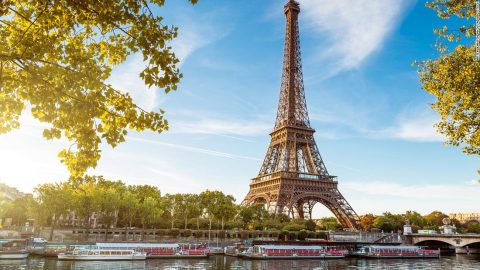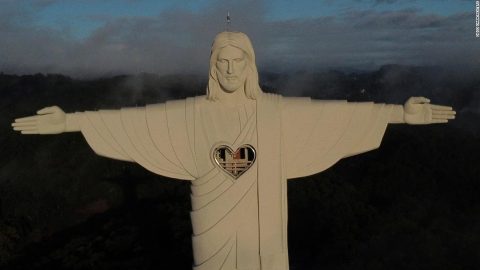(CNN) — From Mumbai’s packed commuter trains to overnight express mail trains akin to a city on wheels, and the astonishing Darjeeling & Himalayan “Toy Train,” railways are one of India’s most recognizable features.
Without them, it’s unlikely the country would have developed into the economic superpower we see today.
However, as the country evolves, its railways are under increasing pressure to move with the times, deliver faster journeys and more freight capacity to serve India’s expanding industries.
Traditional systems, some dating back to the days of the British Empire, might have served India well but they’re increasingly outdated, especially when viewed against the rapid progress being made by India’s neighbor and rival for regional supremacy — China.
Serving every level of society and communities from the smallest rural village to some of the world’s most densely populated cities, the network faces an almost endless set of conflicting demands to keep the country moving.
You can live like a king aboard the Maharajas’ Express, a hotel-on-wheels that’s considered one of India’s most luxurious trains.
Made up of 126,510 kilometers (78,610 miles) of track in total, the Indian Railways (IR) network is the fourth largest in the world, operating 19,000 trains every day and serving almost 8,000 stations. More than 12,700 locomotives are available to haul 76,000 passenger coaches and almost three million freight wagons.
The first Indian railways were proposed as far back as 1832 — just seven years after the opening of England’s Stockton & Darlington Railway, the world’s first public rail line.

India’s modern, semi high-speed Tejas Express train began operations in 2017 in New Delhi.
Arvind Yadav/Hindustan Times/Getty Images
However, it wasn’t until April 1853 that the first section of the Great Indian Peninsular Railway opened to passengers, connecting Bombay (now Mumbai) and Thane. India’s first high-speed passenger railway will link the same two cities when it opens later this decade as part of the Mumbai-Ahmedabad bullet train line.
“Although India’s railways were largely developed by the British for military purposes, Indians took to them like almost nowhere else, creating almost insatiable demand and massive expansion in the second half of the 19th century,” says Wolmar.
“Whether it was for business or family matters, pilgrimage or commuting, this demand made the railways profitable and they reached every corner of India much sooner than many other parts of the world.
“They may not have been built to benefit Indians but the railways delivered a fantastic side-effect that continues to power the country in the 21st century.”
Low speeds, high ambitions
In 2019-20, IR carried more than 8 billion passengers and hauled 1.2 billion tonnes of freight. It is the country’s largest employer and with 1.4 million staff is one of the largest non-military organizations in the world.
In railway terms it is only outdone by the two million workers of China Railway.

A passenger looks out from the window of a long-distance train at a railway station in Mumbai on January 17, 2022.
Indranil Mukherjee/AFP/Getty Images
But when compared to European railways or those of China, Japan or Korea, average speeds remain disappointingly low. A few special express trains can run at 160 kph (100 mph) or slightly more, but the national average for long-distance express is just 50 kph (31.4 mph), while ordinary passenger and commuter trains barely scrape over the 32 kph (20 mph) mark.
Freight trains average around 24 kph (15 mph) and generally have a maximum speed of just 55-75 kph. Congestion is expected to increase over the next 30 years unless more capacity is provided.
Currently, seven trunk routes totaling 16% of the overall network carry 41% of all traffic. Around a quarter of IR’s network is operating at between 100% and 150% of nominal capacity, which can create huge knock-on effects across the country when disruption occurs.
India’s three-pronged solution? Create a new generation of high-speed passenger railways between major cities, construct thousands of miles of new high-capacity cargo railways known as dedicated freight corridors (DFCs) and electrify 100% of the existing network by 2024.
It’s a hugely ambitious strategy but the first DFCs are already in operation and electrification work is proceeding rapidly. Three more Dedicated Freight Corridors totaling 5,750 kilometers are planned to augment the initial pair of routes due for completion this year.
High speeds
But, like Japan and China before it, India views high-speed rail as the key to reducing journey times, increase capacity and accelerate economic activity.
An ambitious National Rail Plan, announced in 2021, envisages that all major cities in north, west and south India should be connected by high-speed rail. Cities between 300 kilometers and 700 kilometers apart with a population of at least one million are being prioritized.
India has enlisted the help of Japanese technology, engineers and finance to assist in the construction of its first line, a 508-kilometer link between Mumbai and Ahmedabad in western India.
A further 12 routes could gain high-speed links over the coming decades if all proposals come to fruition.

The Vande Bharat Express, a semi high-speed train, leaves New Delhi Railway Station on February 15, 2019.
Sanjeev Verma/Hindustan Times/Getty Images
The National High-Speed Rail Corporation Ltd (NHSRCL), set up to finance, construct and manage India’s bullet train projects, has also gained approval for eight new lines linking New Delhi and Varanasi (958 kilometers), Lucknow-Ayodhya (123 kilometers), Mumbai-Nagpur (736 kilometers), New Delhi-Ahmedabad (886 kilometers), New Delhi-Amritsar (480 kilometers), Mumbai-Hyderabad (711 kilometers), Varanasi-Howrah (760 kilometers) and Chennai-Mysore (435 kilometers).
Four more corridors were proposed in early-2022, taking the total to more than 8,000 kilometers. If approved, lines would also be built between Hyderabad and Bangalore (618 kilometers), Nagpur-Varanasi (855 kilometers), Patna-Guwahati (850 kilometers) and Amritsar-Pathankot-Jammu (190 kilometers), creating the second longest high-speed rail network in the world.
When the Mumbai-Ahmedabad project was unveiled by Prime Minsters Narendra Modi and Shinzo Abe in 2017 it was originally hoped that bullet trains would be running in time for the 75th anniversary of Indian independence on August 15 this year, but numerous challenges and delays have pushed completion back to at least 2028.
Arguments over the route and protests by farmers and regional politicians over the loss of agricultural land caused significant delays to land acquisition and route surveys in Maharashtra state. Echoing similar anti-high-speed rail sentiment in other countries, most notably the UK, Chief Minister Uddhav Thackeray questioned the benefit of the scheme and dismissed it as a “white elephant.”
By September 2021, just 30% of the required land in Maharashtra had been acquired, compared to 97% in Gujarat and 100% elsewhere.

Former Japanese Prime Minister Shinzo Abe and Indian Prime Minister Narendra Modi pose in front of a high-speed train simulator in Gandhinagar, India, on September 14, 2017.
Kyodo News/Getty Images
“In fact, Indian Railways has already embarked on a project to raise speeds on existing corridors to 160 kph by upgrading track and signaling. A dedicated freight network is also being built nationally to take freight trains out of the system and decongest trunk routes.”
CNN reached out to Indian Railways for comment on its National Rail Plan, put did not receive a response.
Elevated viaducts
To minimize land take and potentially hazardous interfaces with existing roads or railways, more than 90% of the $15 billion Mumbai-Ahmedabad route will run on elevated viaducts, a decision which added $1.3 billion to the overall cost.
A 21-kilometer section north of Mumbai will be underground — including a seven-kilometer undersea tunnel.
Eleven elevated stations on the line will serve Thane, Virar, Boisar, Vapi, Bilimora, Surat, Bharuch, Vadodara, Anand, Ahmedabad and Sabarmati. Stations will provide easy interchange with existing IR services.
However, unlike other high-speed trains such as the French TGV or Eurostar, India’s bullet trains will not be able to run over existing tracks to reach their destination. From their inception, India’s railways have used a broader than usual track gauge of 1,676 millimeters (5 feet 6 inch) whereas the Japanese-built line will employ the worldwide “standard gauge” of 1,435 millimeters.
“The trains on Indian Railways, with their social obligation, run a bouquet of services, catering to all classes from poorest of the poor to the affluent class but the high-speed railway is being built as an independent corridor with international standard gauge and a dedicated network, not mixing with national corridors,” says Aklekar.

Commuters wait on the platform during rush hour as a local train arrives in Mumbai, on February 1, 2022.
Ashish Vaishnav/SOPA Images/LightRocket/Getty Images
Captive 10-car trains derived from the Japanese E5 “bullet train” will operate at up 320 kph, slashing the end-to-end journey time from the current seven hours to just over two hours for the fastest services.
Each train will seat up to 1,300 passengers and include multi-purpose rooms for mothers plus compartments for heavy luggage. Fares will start at just 250 Indian rupees ($3.30), rising to around 3,000 Indian rupees ($40) for an end-to-end journey.
“This project is about technology,” concludes Aklekar.
“India needs to make a start at some point and that time is now. It takes time to adapt and settle new technologies and lines. For example, Japan’s Hokkaido Shinkansen took 42 years to become fully operational. If we do not start now, we will be left behind.”
However, IR’s precarious financial position continues to cloud this optimistic picture. Over the last six years the company’s costs have been increasing more than twice as fast as its revenues as productivity continues to decline.
A recent doubling of staff wages has exacerbated the issue while pension contributions account for an incredible 71% of operating expenses. Staff numbers have been declining but a recent recruitment drive aims to add another 140,000 employees by June.
In 2014, the-then Railway Minister Sadananda Gowda lamented that IR “is expected to earn like a commercial enterprise but serve like a welfare organization,” citing losses from cheap fares in the passenger sector.
Highly publicized projects such as the Dedicated Freight Corridors, major station redevelopments, logistics parks and the introduction of new passenger trains have all languished, while IR has continued to lose market share in both freight and passenger sectors.
IR’s problems with costs, congestion and the need to invest heavily in new and upgraded infrastructure are not unique, although their scale is somewhat greater than most.
The Indian government will be desperate to see its flagship rail projects complete and delivering the promised benefits soon, not only to stimulate economic recovery but also to show its rivals that it too can deliver world-class 21st century transportation.




Recent Comments